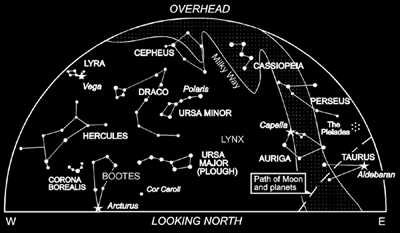 In October, many of us will be leaving the towns and heading towards the villages to celebrate Dasain and Tihar. With a lot of free time, clear and dark skies and longer nights, it will be ideal for studying the heavens.
In October, many of us will be leaving the towns and heading towards the villages to celebrate Dasain and Tihar. With a lot of free time, clear and dark skies and longer nights, it will be ideal for studying the heavens. As a beginner, you don't really need a heavy-duty telescope even a pair of binoculars (10x50 mm) will do. In fact, there are many objects in the sky (planets, galaxies, nebulae, star clusters), which can be seen through binoculars.
How about starting by identifying some of the prominent constellations like Cetus, Orion, Andromeda, as well as the Milky Way band and Dhruba Tara (Polaris). Identifying Polaris and the constellations are crucial for beginners, as this helps us navigate the celestial coordinate system. This month look out for the following:
The Sun: During all of the month except the last day, the sun is passing through the constellation of Virgo. (Don't ever look at the sun with naked eyes.)
The Moon: The new Moon on 3 October is of special significance because the sun and the moon are almost directly in line with the earth and will produce a partial (annular) solar eclipse visible from Europe and North Africa (not from South Asia).
Inner Planets: During the whole of October, the innermost planet Mercury is theoretically an evening star but because of its low altitude, cannot be seen. Venus brightens to become dazzling in Libra but remains low in the southwest as evening twilight fades.
Outer Planets: Mars is the headliner: the red planet rises around 8PM at mid-month and doubles its brightness. It reaches opposition on Sunday 30 October when its magnitude makes it the second brightest object in the sky after Venus has set. During the whole of the month Jupiter lies too near to the sun to be seen and vanishes behind the Sun on 23 October. Saturn is the only other planet visible in the night sky, rising just after midnight at the start of the month. Uranus and Neptune are telescopic objects visible in the evening sky in Aquarius and Capricornus respectively. The Milky Way, our own galaxy, now is highest at nightfall. A beautiful edgewise view can be seen in country skies during October's moonless opening week.
Meteor Showers: Some more remnants of Halley's comet may be seen in the early hours of 21 October, when the earth encounters left-over dust of the comet producing the Orionid stream. Up to 25 shooting stars are expected, but this number may be reduced by the presence of the gibbous waning moon. Earlier in the month on the morning of 8 October, a slight increase in the number of shooting stars overnight marks the peak of the Draconid meteor shower, visible in the constellation of Draco.
Dear Science Teachers! Is your school looking for a telescope? The Permission to Dream Program (PTD) donates telescopes to schools and colleges around the world which are seriously interested to conduct stargazing for children.
http://www.space-frontier.org/Projects/permission/
Good luck and a happy Dasain to all you stargazers out there.
Kedar Sharma Badu of the Pokhara Galileo Astronomical Society writes this column on the last Friday of every month, kedarbadu@yahoo.com


